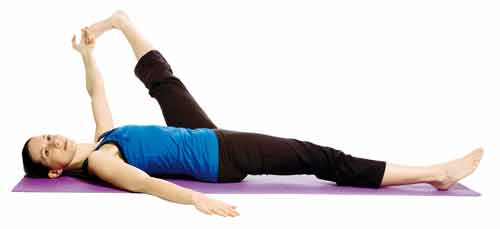 Running for long distances, such as a marathon, isn’t easy on your body. It places high demands on all of its resources—more so, on your legs. Runner’s knee, tightness in the hamstring, shin splits and low back pain are some of the common complaints of runners. The good news is that yoga can help in each of them.
Running for long distances, such as a marathon, isn’t easy on your body. It places high demands on all of its resources—more so, on your legs. Runner’s knee, tightness in the hamstring, shin splits and low back pain are some of the common complaints of runners. The good news is that yoga can help in each of them.
Runner’s knee
The main complaint of those with runner’s knee is pain in the centre of the knee, just behind the knee cap. Pain usually worsens while getting up from a squatting position, climbing and, of course, running. Runner’s knee is common in women and in those with flat feet. Strengthening the quadriceps, while avoiding excess strain on the affected knee till symptoms subside, works best for this condition.
Chair pose [utkatasana]
Standing with your feet together, lift your arms up to the shoulder level. Then, bend the knees, lowering yourself till you are at a chair level. Don’t go all the way down. Repeat this up-down movement several times, keeping your back straight.
Single leg raising [uttanpadasana with one leg]
Lie on the mat. Keep the left leg bent at the knee. Keep the right leg straight, knee extended completely and lift up to 45 degrees. Alternately, you can place a rolled towel below the right knee and press the knee on the towel. Hold for 10 breaths and release. Repeat this contraction and relaxation movement several times with both the legs.
Hamstring tightness
Hamstrings are the muscles on the back of your legs, behind the knees. To check if you have tight hamstrings, lie on a flat surface and lift the leg, keeping the knee straight. Good hamstring flexibility should allow you to lift the leg to a right angle. Anything below 80 degrees indicates hamstring tightness. Releasing tight hamstrings goes together with releasing tight hip flexors. You can’t work on one while ignoring the other as they are co-dependant.

Head-to-knee pose [janusirasana]
Sit with your legs stretched out and feet together. Bend the right knee and place the sole of the right foot pressed against the left thigh. Lift both the hands up, and bending from the waist, take the hands towards the right foot and forehead close to the right knee. Without bending the knees, reach the hands forward to circle the fingers around the foot.
Cobbler’s pose [baddha konasana]
Sit with your back straight and aligned with the neck. Bend the knees and bring the soles of the feet to touch each other. Clasp the ankles and draw the feet towards the groin, all the while keeping your back straight. Keep pulling your feet closer, till the heels almost touch the groin. Stay in this position for 10 breaths.
Shin splints
This is the sharp pain you experience in the shin area, commonly experienced by runners. Anything from running on unsuitable surface, improper footwear, or over-training could be the culprit behind the pain. What works best in case of shin splints is rest. The below postures help prevent shin splints and hasten recovery.
Mountain pose [tadasana on toes]
Stand with your feet together. Lift the heels up and shift the weight on to the toes. Keep the back straight.
Inverted pose [ardh sarvangasana]
Lie on the mat with the hands by the side of the body, palms facing up. Lift both the legs up together, keeping the knees straight, and slowly lift the buttocks off the mat. Place the palms on the mid back as you shift your weight towards the upper back. Keep the legs straight. This is a mild form of inversion and can even be done with the legs going up against a wall. Lie close to the wall with the back flat on the mat while you keep your legs supported on the wall.
Low back pain
For runners, it’s important to first ascertain if running is causing the back pain or only worsening it. If the back pain doesn’t worsen after running, it could be due to poor posture or weak abdominal muscles. Running-related back pain is usually due to tight hamstrings and bad running form.
Bridge pose [setubandhasana]
Lie on the mat with the knees bent and hands by the side. Lift the pelvis and lower back away from the floor, and bring the thighs in line with the upper body. Hold for a few breaths and to release, slowly take the
back down.
Supine spinal twist [supt vakrasana]
Lie on the mat, bend the right knee and draw it up towards the chest. Cross the right knee over the left and place it on the floor on the left side. You may even straighten the right knee. Keep the left knee bent. To add variation, stretch both the legs straight out to the left side while looking towards the right.
Include yoga in your running schedule even if you don’t have any of the above issues. Surya namaskar and the warrior series of poses helps runners build stamina, endurance and will power.
